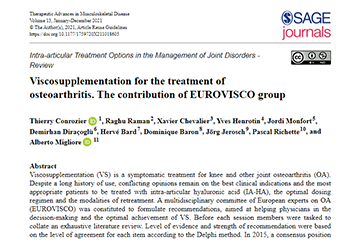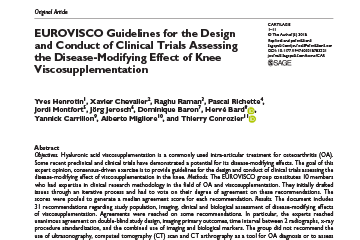LABRHA is supporting Eurovisco by organizing its annual board since 2014.
We are proud to be Eurovisco’s partner.
Abstract
Objectives
The 3 aims of the work were to identify population subgroups that can benefit the most from viscosupplementation (VS), to provide recommendations on injection techniques, and to discuss VS appropriateness in clinical situations that are commonplace in daily practice.
Methods
The task force members voted on their degree of agreement on 27 statements, 36 recommendations, and 22 clinical scenarios using a 9-point scale. The strength of agreement/appropriateness/recommendation (SOA/SOR) was classified as strong if the median agreement score was ≥8. The level of consensus (LOC) was also obtained.
Results
Among the assumed predictors for VS failure, obesity, radiographic severity, large synovial fluid effusion, severe patellofemoral involvement, major malalignment, and gross joint instability received a large majority of agreements. The lateral mid-patellar approach was recommended for knee injection. Imaging guidance was unanimously recommended for hip and ankle. Agreement was achieved to strictly respect the dosing regimen proven by controlled trials. There was agreement for treating with VS patients with mild to moderate knee and hip OA, with normal weight or moderate overweight, insufficiently improved by first-line therapies, or who do not wish get oral treatment or who have contraindications to pain killers. The group considered the patient’s wishes as a key element in therapeutic decision making.
Conclusion
Based on literature data and clinical experience, the EUROVISCO group proposed a set of recommendations for optimizing the results of VS, aimed to help practitioners, especially in some cases in which the patients’ specificities make the therapeutic decision difficult.


